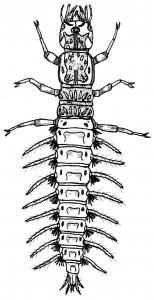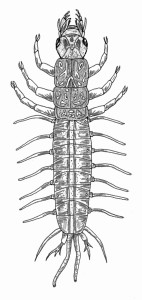Rebecca Shoer, Mid-Atlantic Save Our Streams Coordinator
Invertebrates are the unsung heroes of the natural world. They make up 97% of the world’s animal species, but are often pushed to the fringes of conservation conversations to make room for bigger and splashier mascots like pandas, tigers, and elephants. Though some insect pollinators have started getting well-deserved attention in recent years, there are hundreds of thousands of invertebrate species that seem doomed to obscurity.
Here at the League, however, we know how important these creatures are, especially in terms of what they can tell us about the health of our streams. When our monitors head out into the field, they can measure water quality by looking at the species of benthic macroinvertebrates living in the stream. Benthic macroinvertebrates are animals without a backbone that live in the streambed and can be seen without a microscope. Some are very sensitive to pollution in the water, while others are more tolerant of factors like high salt concentrations or low levels of oxygen. By figuring out who is living in a stream, we can measure how healthy the stream is – and whether or not it’s safe for humans to use.
Although I’ve worked with a few bugs in the past, I haven't spent much time with the ones that live in our streams. With a few field guides, a magnifying glass, and lots of help, however, I’ve started making my way into the world of macros. One of the first things I’ve learned is that samples, illustrations, and even photos can only take you so far – nothing replaces experience in the field with live organisms.
By getting out and observing real live stream bugs, I’ve started to recognize the different ways that macroinvertebrates move in the water. Some wriggle, some crawl, and some even do “push-ups” while sitting in the tray. Watching how a macro moves helps you narrow down what group it belongs to and successfully determine its identity.
Gills are another great clue for identification. The first trick when looking for gills is realizing that invertebrate gills look nothing like fish gills, and they can be just about anywhere on a bug's body! Some macros have gills on the tip of their tail, while others have gills under each leg like tufts of hair.
As subtle as gill placement might seem to us, it’s one of the most important ways to distinguish between groups. Take the dobsonfly and fishfly larva, for example. On first glance they may look nearly identical, but take a look at their gills. Notice anything different between them?


The dobsonfly larva (left) has gill tufts under each appendage, while the fishfly larva (right) does not!
Observing movement and looking closely at gills are only two of the identification tricks we use in the field. There are many more to learn! But you don't have to master them all before you become a stream monitor. You can always whip out your trusty field guide or the handy-dandy Aqua Bugs app to help you with a tough ID.
Want to brush up your bug skills? Follow us on Facebook, so you won't miss new episodes of our Meet a Macro video series. Or, attend our master class on stream bug identification.
Become a Macro Master
Cover image: Chesapeake Monitoring Outreach Coordinator Emily Bialowas teaches a new stream monitor to ID stream bugs.